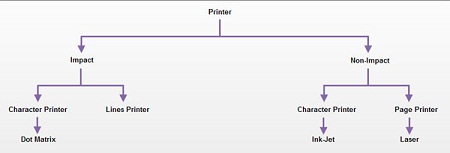Printers are Output devices used to prepare permanent Output devices on paper. Printers can be divided into two main categories :
Impact Printers : In this hammers or pins strike against a ribbon and paper to print the text. This mechanism is known as electro-mechanical mechanism. They are of two types.

Character Printer : It prints only one character at a time. It has relatively slower speed. Eg. Of them are Dot matrix printers.
Dot Matrix Printer : It prints characters as combination of dots. Dot matrix printers are the most popular among serial printers. These have a matrix of pins on the print head of the printer which form the character. The computer memory sends one character at a time to be printed by the printer. There is a carbon between the pins & the paper. The words get printed on the paper when the pin strikes the carbon. There are generally 24 pins.
Laser Printer is a type of printer that utilizes a laser beam to produce an image on a drum. The light of the laser alters the electrical charge on the drum wherever it hits. The drum is then rolled through a reservoir of toner, which is picked up by the charged portions of the drum. Finally, the toner is transferred to the paper through a combination of heat and pressure.
This is also the way copy machines work. Because an entire page is transmitted to a drum before the toner is applied, laser printers are sometimes called page printers. There are two other types of page printers that fall under the category of laser printers even though they do not use lasers at all. One uses an array of LEDs to expose the drum and the other uses LCDs. Once the drum is charged, however, they both operate like a real laser printer. One of the chief characteristics of laser printers is their resolution – how many dots per inch (dpi) they lay down.
The available resolutions range from 300 dpi at the low end to 1,200 dpi at the high end. In addition to text, laser printers are very adept at printing graphics, so you need significant amounts of memory in the printer to print high-resolution graphics. To print a full-page graphic at 300 dpi, for example, you need at least 1 MB (megabyte) of printer RAM. For a 600 dpi graphic, you need at least 4 MB RAM.
Because laser printers are non-impact printers, they are much quieter than dot matrix or daisy-wheel printers. They are also relatively fast, although not as fast as some dot-matrix or daisy-wheel printers. The speed of laser printers ranges from about 4 to 20 pages of text per minute (ppm). A typical rate of 6ppm is equivalent to about 40 characters per second (cps).
Non-Impact Printers : There printers use non-Impact technology such as ink-jet or laser technology. There printers provide better quality of O/P at higher speed. These printers are of two types :
Ink-Jet Printer : It prints characters by spraying patterns of ink on the paper from a nozzle or jet. It prints from nozzles having very fine holes, from which a specially made ink is pumped out to create various letters and shapes. The ink comes out of the nozzle in a form of vapors. After passing through a reflecting plate, it forms the desired letter/shape at the desired place.
 Dinesh Thakur holds an B.C.A, MCDBA, MCSD certifications. Dinesh authors the hugely popular
Dinesh Thakur holds an B.C.A, MCDBA, MCSD certifications. Dinesh authors the hugely popular